Menus
- Crossover bikes in comparison test
- More reserves than with classic street bikes
- Three-cylinder hisses beguilingly
- Throttle response a little harder
- Always feels too high idle speed
- Maneuvering the Crossrunner is not easy
- Kawasaki Versys is a real feel-good motorcycle
- How does series tires fare?
- Old-fashioned, British-quirky
- Less than five liters per 100 kilometers
- Prices, equipment, model variants
- Equipment in detail
- MOTORCYCLE scoring
- MOTORCYCLE test result
- Technical specifications
- Used middle class travel enduro bikes in price comparison
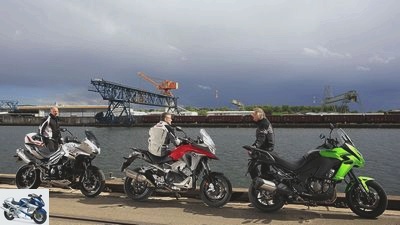
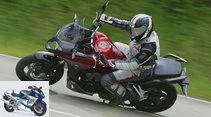
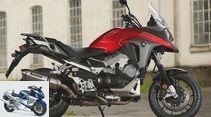
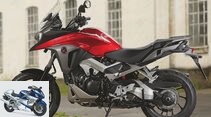
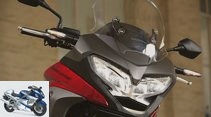
28 photos
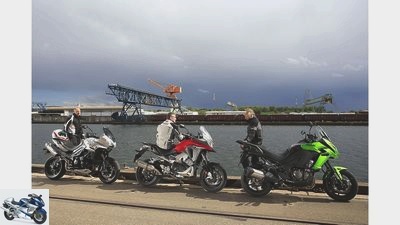
1/28
After the romping comes the touring: gasoline talks at the former coal port in Karlsruhe.
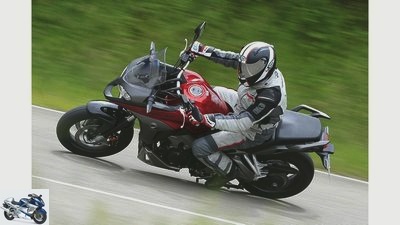
2/28
The handlebars on the high risers come far towards you.
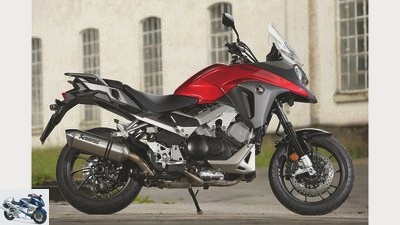
3/28
Together with the rather narrow knee joint, this results in a compact sitting position.
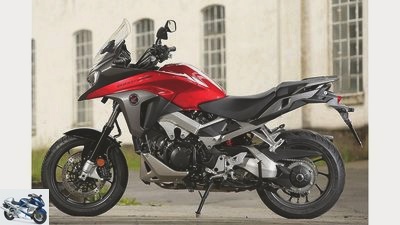
4/28
Let’s start with the Honda Crossrunner.
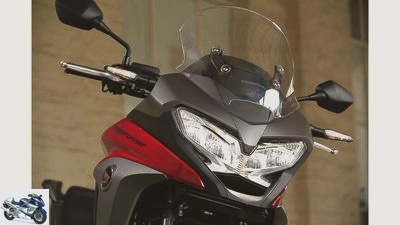
5/28
Not adjustable disc; bright, easily recognizable full LED headlights. Turn signals at the front switched to permanent light to enlarge the silhouette.
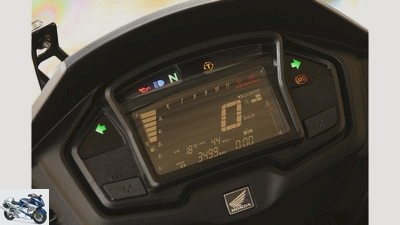
6/28
Instruments with a rough tachometer under reflective glass.
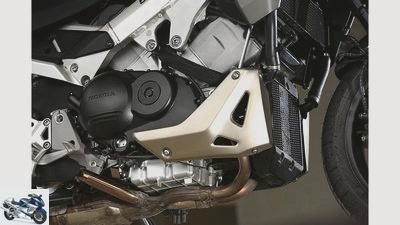
7/28
The supporting V4 has two water and one oil cooler.
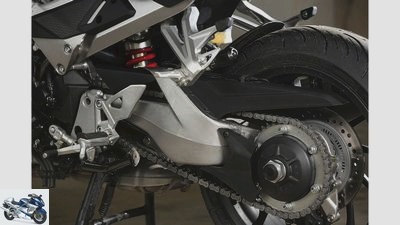
8/28
Honda Crossrunner.
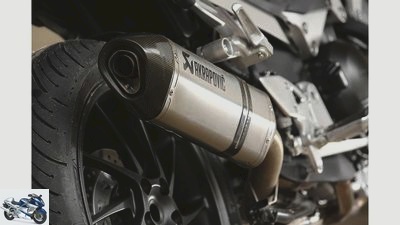
9/28
At Honda’s Crossrunner, the Akrapovic exhaust and main stand cost extra.
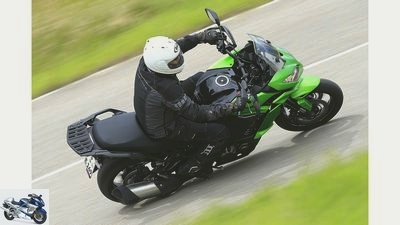
10/28
The widest handlebars and plush seats characterize Kawasaki’s feel-good motorcycle.
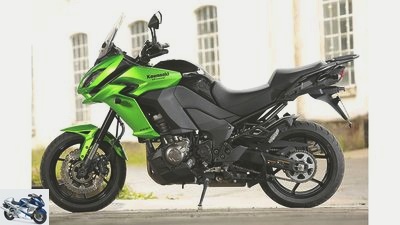
11/28
It continues with the Kawasaki Versys 1000.
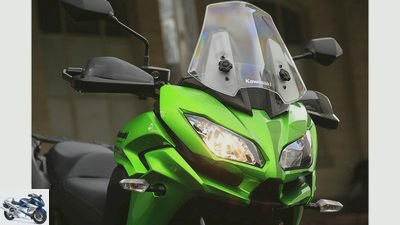
12/28
Disc height adjustable with knurled screws; Hand protectors as an extra. Inexplicably solved: with the low beam, only the right headlight is lit..
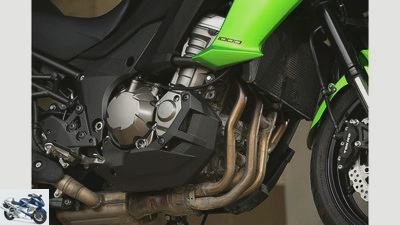
13/28
The strong and elastic in-line four-cylinder runs a little rougher than the other two engines.
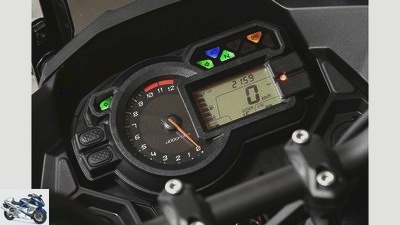
14/28
The analog tachometer with the fine needle is a treat for the eyes.
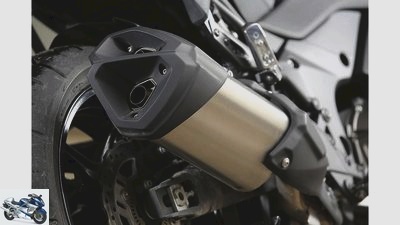
15/28
Kawasaki Versys 1000.
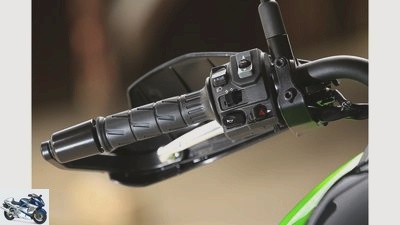
16/28
The hand guards from the accessories program are mounted on the Versys.

17/28
The newly contoured seat behind the previous tank improves contact with the machine.
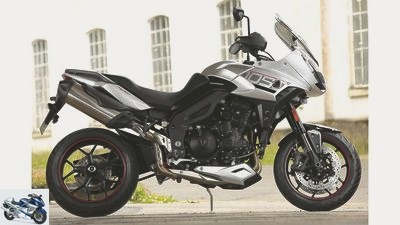
18/28
Last but not least: Triumph Tiger 1050 Sport.
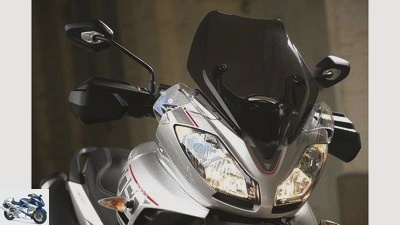
19/28
The height-adjustable windshield and side wind deflectors provide effective protection. With high / low beam, two of the four headlights each light up.
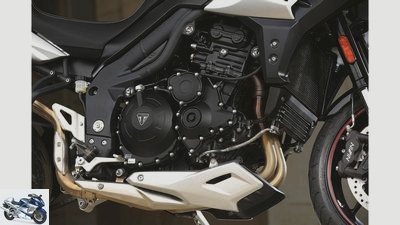
20/28
The smooth 1050 triple runs smoother thanks to many changes in innards and new software.
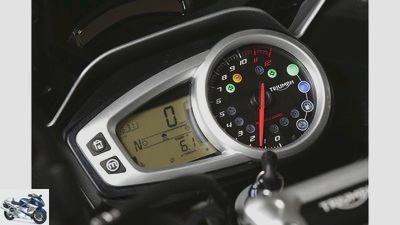
21/28
New: gear display in the cockpit.
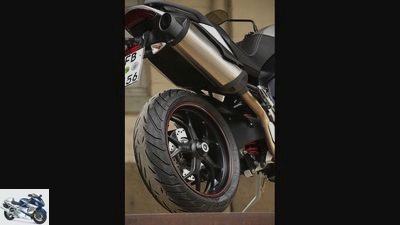
22/28
Crossover comparison test with the Honda Crossrunner, Kawasaki Versys 1000 and the Triumph Tiger 1050 Sport.
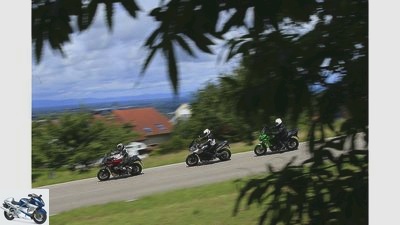
23/28
Picturesque: the Baden Rhine plain, between the Black Forest and the Vosges.
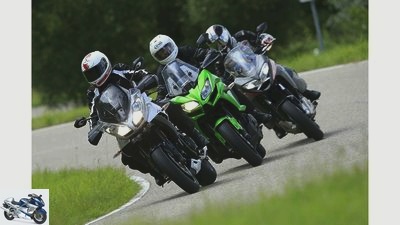
24/28
Trio infernale flying in formation. In fact, Crossrunner and Versys sail around corners more neutrally and more manageably than the Tigers.
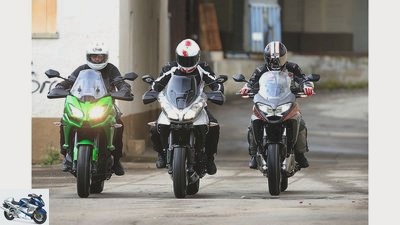
25/28
The Honda Crossrunner, Kawasaki Versys 1000 and Triumph Tiger 1050 Sport compete against each other in the crossover comparison test.
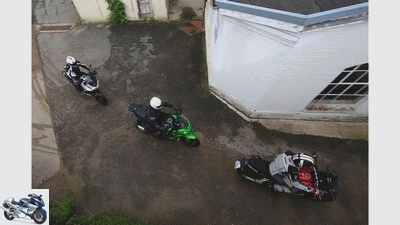
26/28
Honda Crossrunner, Kawasaki Versys 1000 and Triumph Tiger 1050 Sport.

27/28
Honda Crossrunner, Kawasaki Versys 1000, Triumph Tiger 1050 Sport.
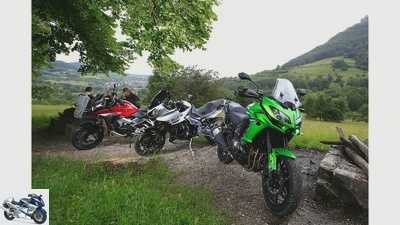
28/28
Honda Crossrunner, Kawasaki Versys 1000 and Triumph Tiger 1050 Sport.
Kawasaki Versys 1000, Triumph Tiger 1050 Sport and Honda Crossrunner
Crossover bikes in comparison test
As such, the Kawasaki Versys 1000, Triumph Tiger 1050 Sport and Honda Crossrunner, with their 17-inch front wheels, wide 180 mm rear slips and cast wheels, don’t exactly stand for off-road inserts. But moderately long suspension travel, wide handlebars and characteristic motors at a price of around 12,500 euros each invite you to explore the surroundings and your limits.
“Looks like in the tropics,” says Kawasaki rider Gabriel. We enjoy the steamy slopes of the Northern Black Forest National Park, covered with bright green fur, where the sun comes out again after a rain shower. We are now in Au am Rhein – the name says it all, there is still a lot of alluvial forests here. After the floods of rain, poor people from the Old Rhine look for new, no, ancient ways. Running water floods parking lots and streets. Close your visor, open your eyes and through. And then hope that the underpants will dry quickly.
Buy complete article
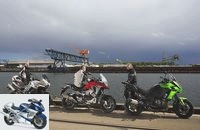
Kawasaki Versys 1000, Triumph Tiger 1050 Sport and Honda Crossrunner
Crossover bikes in a comparison test
Kawasaki Versys 1000 and the freshly redesigned Triumph Tiger 1050 Sport certainly do not surrender. Crossover machines stand for criss-cross, adventure feeling included. The term literally means crossing or transition. Fits.
More reserves than with classic street bikes
Because wide tubular handlebars, each 16 centimeters of ground clearance under the engine and proper suspension travel definitely represent enduro genetics, an “X chromosome”. The Honda has the “cross” dominant in its name. Suspension travel at the front between 140 millimeters (Triumph Tiger 1050 Sport) and 150 millimeters (Kawasaki Versys 1000) and at the rear from 148 (Honda Crossrunner) to 150 millimeters (Triumph) offer significantly more reserves than with classic street motorcycles.
All three machines have 17-inch cast wheels with 180 mm rear tires and an aluminum main frame with a rear frame bolted on for easy repair. Furthermore, steel tanks with a volume of 20 to 21 liters, stainless steel exhaust systems with solo silencers, immobilizers and on-board computers. Not to forget moderately high windows on not too voluminous front panels and comfortable seating. Last but not least, adjustable hand levers, chic double to quadruple headlights and LED taillights. Safety is of course provided by ABS systems and traction controls that can be switched off with two levels on the Honda Crossrunner and Triumph Tiger 1050 Sport and three on the Kawasaki Versys 1000.
Three-cylinder hisses beguilingly
The engine concepts are individual, typical of the brand and with a strong character: V4 for the Honda Crossrunner, in-line four-cylinder for the Kawasaki Versys 1000 and, of course, a triple for the Triumph Tiger 1050 Sport: three lions are the coat of arms of England, three-cylinders are the core of Triumph. Honda’s Crossrunner is content with 782 cm3 displacement, from which it gets 106 hp. As the VFR 800 X, it embodies the elevated version of the VFR 800 F, with its engine dating back to 2002 with V-Tec valve control. The displacement of the Kawasaki and Triumph is almost identical, 1043 and 1050 cubic. The 120 hp Kawa engine is the torque-optimized unit from the Z 1000 presented in 2010. Triumph’s great triple goes back to 2005, the first Sprint ST 1050.
The nominally 126 hp three-cylinder hisses and roars beguilingly. Not loud or aggressive, just unmistakably throaty, the tiger marks its territory. Rumble in the jungle! Like the Speed Triple, the Triumph Tiger 1050 Sport now has a heavily machined three-cylinder. Ride-by-wire as a requirement for traction control and three driving modes (sport, road and rain) is just the tip of the iceberg. There was also a modified cylinder head with new throttle bodies, new pistons and a modified balance shaft. There is also a new control unit with adapted software for the electronics package. Now the three-cylinder is back on its feet again.
Ten-hole injection nozzles, iridium spark plugs with modified ignition coils, modified intake ducts such as manifolds, the revised airbox, slightly increased compression and a silencer with more throughput ensure improved fuel efficiency and freer breathing. The switching mechanism and a servo-assisted slipper clutch, like the one on the Versys, are also new. The clutches of the Kawasaki Versys 1000 and Triumph Tiger 1050 Sport can be easily pulled with two fingers and metered well. Not so on the Honda Crossrunner: its hydraulically operated clutch disconnects more digitally, on or off, and that on the last millimeter of lever travel.
Throttle response a little harder
The tiger goes on stalking much more smoothly. Okay, he still occasionally acknowledges engaging first gear with a wooden gear shift. But then the gears slide so smoothly and smoothly through the switch box that it is a delight. Honestly, friends, the 1050 triple has never run so smoothly before! It seems acoustically calm, purrs like a cuddly cat and mechanically runs almost free of vibrations. As if its crankshaft was rotating in butter plain bearings. Really inspiring, to spontaneously fall in love again. The direct reaction to gas commands fits in with this. The Triumph Tiger 1050 Sport is easy to handle, not too aggressive, even in Sport mode. Great. In absolute and percentage terms, the Triple has by far the largest stroke of the three engines.
The Kawasaki Versys 1000, which is still homologated according to Euro 3, follows the twist of the throttle not so directly, almost a little delayed. This also applies to the more fiery F and full power modes. Typically for Kawasaki, the throttle valves offer minimal resistance to reopening after rolling, which makes the throttle response a little harder. But the Versys spoils you with the beariest acceleration deep in the speed cellar. It runs smoothly even at 40 km / h in sixth gear. What an elastic engine! He makes early upshifts a pleasure, shift-lazy gliding a freestyle. The muffled and sonorous whispering four-cylinder of the Kawasaki Versys 1000 is a force, its gearbox works inconspicuously. However, fine, pixelated vibrations around 6000 revolutions are not quite as cultivated. They tickled Kawa driver Gabriel on the highway journey.
Always feels too high idle speed
From 6500 rpm, the Kawasaki Versys 1000 pushes out more torque than the Triumph Tiger 1050 Sport, which is ultimately equally strong beyond the 9000 mark. Wait a minute: 6500 revolutions? These are a magical limit for the driver of the Honda Crossrunner, because up to this mark only one inlet and one outlet valve work in each cylinder. Only then does the rising oil pressure activate the second valve in each intake and exhaust tract by means of a locking bolt. The effect is enormous: Accompanied by a sensual snarling that gets under the skin, the particularly short-throw V4 now changes pitch and character. Turn unleashed, no, its little 72 flasks storm free with a stroke of only 48 millimeters and free into five-digit ranges. Rated speed 10,250, the power has to come from somewhere.
At such speeds, the two 1050s have already hoisted the red flag in their pleasant analog tachometers. After all, the V4 is typical for Honda as indestructible. The high-quality Akrapovic exhaust at 699 euros sounds robust, not riotous and chubby. However, it does not perform better. The optional gearshift works great for 290 euros. Simply tap the gear lever with the tip of your foot and the next higher gear is already in place. That flup. On the other hand, the idle speed that always feels too high is annoying. You can not read it exactly, because Honda finds display instruments chic, which only roughly estimate the speed, not really read. Even more than the Kawasaki Versys 1000, the Honda Crossrunner increases the idle speed for a long time after a cold start.
Honda’s V-Tec system is supposed to improve the filling, optimize the engine characteristics and combine the advantages of two- and four-valve engines. But that remains pure wishful thinking with the Honda Crossrunner. A whopping 11.8 seconds in sixth gear for the passage from 60 to 140 km / h is very poor: a Yamaha XJ 900 F from 1985 only needs ten seconds for this.
Maneuvering the Crossrunner is not easy
And our two current in-line engines have a full third more displacement than the VFR 800 X. No wonder that they each pull off this exercise in just 7.8 seconds. It’s a different world. If you don’t want to lose touch, you always have to drive the Honda Crossrunner one or two gears lower and cheer higher than the Kawasaki Versys 1000 and Triumph Tiger 1050 Sport.
Including the optional main stand, the Honda Crossrunner weighs a whopping 245 kilograms, one kilogram more than the larger Triumph Tiger 1050 Sport – tribute to V-Tec and two cylinder banks of the V4. Well, the narrow rear two-cylinder bench at least ensures tight knee closure. The handlebars are close to the chest. This is quite compact for tall people, especially since the pronounced hollow of the seat, which is only height-adjustable here, places the driver far in front. Although the Honda Crossrunner looks a tad more delicate than the two rivals, its high center of gravity doesn’t make maneuvering easy either.
Kawasaki Versys is a real feel-good motorcycle
At least the 5.30 meter turning circle gives a lot of confidence: the Honda Crossrunner turns on the palm of your hand. The Triumph Tiger 1050 Sport needs 6.17 meters for this exercise, the Kawasaki ranks in between. The Kawasaki Versys 1000 weighs 252 kilos. It is a rolling relaxation program, is extremely balanced and easy to handle. Even jacking up on the standard main stand is easier than with the Honda.
The big buzzer can be directed gently, very easily over the widest handlebar, rolls wonderfully. The contact with the motorcycle is intimate. If necessary, this tourer can also be really quick, drives bold and agile, always predictable. Comfort meets driving dynamics. Opulent upholstered seats pamper you at the front and back. A plush sofa on wheels. Yes, the Kawasaki Versys 1000 is a real feel-good motorcycle. You don’t even want to go down. Just getting into the extremely comfortable back seat is no easy exercise.
How does series tires fare?
Pre-tensioning the spring strut, which is blessed with plenty of reserves, is particularly recommended with passengers in order to gain ground clearance. Because the Kawa scratches the curve (s) early with her footrests. The handwheels for adjusting the spring base are practical on both Japanese models. The high level of suspension comfort of the trio contributes to the pampering experience of the Kawasaki Versys 1000: ride safely without being wrapped in cotton wool. The Bridgestone T 30 “F” harmonize well with the Versys. Everything works calmly, including the three-stage traction control with its clearly distinguishable intervention thresholds. Plump, on the other hand, regulates the traction control of the Honda Crossrunner, hacks extremely in between, and does not allow throttle acceptance long after the impulse.
After all, their Michelin Pilot Road 4 are a power in the wet. The Triumph Tiger 1050 Sport also has good tires: Pirelli Angel ST. Sensitive drivers, however, notice a peculiarity of the Tiger Sport: it does not circle corners completely neutrally and homogeneously. “It feels as if the front and rear wheels don’t exactly follow the same radius,” says test driver Georg Jelicic. This behavior requires constant minor course corrections. “You actually have to turn twice.” The shock absorber responds well enough, also with a pillion passenger. But the Triumph is most susceptible to interference from bumps and asphalt faults, stands up, then looks for a bit of its own lines. Okay, a tiger is the largest of all cats, not a lynx. But the 1050 should drive a bit more panther-like wiry. After all, it has the addition of “sport” in its name. The rather well-damped Triumph tends to react very sensitively even to a few tenths of a bar of too little air pressure. Is that why there is the option of electronic tire pressure monitoring? But even with the correct 2.5 / 2.9 bar, the driving behavior suffers from slightly worn tires. Triumph-typical angle valves on the wheels are praiseworthy. It’s hard to explain why Japanese motorcycle manufacturers put strains and dirty fingers on their customers instead.
Old-fashioned, British-quirky
In general: overpainted stickers, many fine milled parts and anodized metal spoil the tiger trainer. In addition, only the Triumph carries hand protectors and cruise control, on-board socket and USB port as standard. The Kawasaki Versys 1000, on the other hand, is a bit rustic, with clumsy screws and some simple-looking solutions. The Honda Crossrunner shines like the Triumph Tiger 1050 Sport with single-sided swing arm and literally with its extroverted polished, finely welded aluminum frame.
The raised XXL exhaust of the Triumph Tiger 1050 Sport seems a bit old-fashioned, British-quirky. It pretty much restricts the volume of a right suitcase. The front brake bites sharply. Almost too much, on the first lever path. The intervention thresholds of ABS and traction control are linked to the driving mode in two stages. The Triumph now moves particularly confidently on the autobahn: its wide, high and easily height-adjustable windshield, together with the inconspicuous side wind deflectors, provide the best protection. Big drivers, however, complain about a high volume level. As a 1.71-meter-short person, the author felt that on the Kawasaki Versys 1000. Well solved: As with the Triumph, your window can be adjusted without tools, using the front-mounted knurled screws.
Less than five liters per 100 kilometers
Not adjustable at all, but the Honda windshield sits in front of your front quite effectively. The Honda Crossrunner runs straight ahead on the A 5 and A 8. In addition, it certainly not only circles the curves of the northern Black Forest with the most precise steering. Take your bearings, give in and go through with calm. Compliment. It feels like the two Japanese drive almost by themselves, while the tiger needs a little guiding hand: a big cat, not a cuddly cat. The Tiger stiffens noticeably when it is turned quickly in fast alternating curves, the Versys a little. It’s amazing how quickly you get used to the gear displays on the Honda Crossrunner and Triumph Tiger 1050 Sport. With the Kawasaki Versys 1000 it is again like before, to count or to retrofit a gear indicator.
When driven on country roads in compliance with the StVO, all three machines consume less than five liters per 100 kilometers. The redesigned triple of the Triumph Tiger 1050 Sport is particularly economical, with 4.5 liters.
Prices, equipment, model variants
The last criterion is the purchase price. The Honda Crossrunner should cost 12,510 euros including ancillary costs, which is rather optimistically priced in for an 800. For comparison: Honda’s full-blown V4 adventure bike, the Crosstourer with over 1200 cubic meters, costs “only” a good 2000 euros more. No wonder that the little sister is easily available for just under 11,000 euros. And then really worth considering.
Triumph is charging a moderate 12,700 euros for the current Triumph Tiger 1050 Sport, just 200 more than the previous model. So very little extra charge for many improvements. Compliment. In addition, there are a hefty 460 euros in additional costs. If you want to save, the 2015 model remains on sale. It is a matter of weighing up, because the new one is much better, almost all criticisms of the previous model have been eliminated – once harsh throttle response, no traction control, moderate wind protection. As a sandwich child, the Triumph Tiger 1050 Sport even has large and small siblings, the 800 series at prices from 10,100 euros and the 1200 Tiger Explorer suitable for long-distance travel from 13,990 euros. A praiseworthy feature of all Triumphs is the two-year extended warranty with an insurance company after the two-year factory warranty has expired.
12,490 euros plus additional costs are due for the standard version of the Kawasaki Versys 1000. A good offer, even if it is a little rustic. For a surcharge of 800 euros there is the Versys Tourer variant with tank pad, hand protectors and two usable 28-liter suitcases with inner pockets.
The Kawasaki Versys 1000 Grand Tourer costs 14,290 euros. It also has a 47-liter top case, a gear indicator, additional LED headlights, a twelve-volt on-board socket and an engine crash bar. All accessories are also available individually. There is also a follow-up guarantee with 100 percent assumption of the costs for material and wages, for an extra 295 euros per year. Frequent drivers, however, have to bring the Kawasaki to service every 6,000 kilometers, out of time. Honda dealers do not expect the Crossrunner to be inspected until twice the distance; Triumphs are allowed to drive 10,000 kilometers without being checked. All three machines are loyal companions with pretty confident engines: fiery when it counts, calm when it gets difficult. They are motorcycles that will go through thick and thin with you without ever overdoing it. It’s always summer in her saddle. No matter how moody the weather is.
Equipment in detail
Board computer
| Honda Crossrunner | Kawasaki Versys 1000 | Triumph Tiger 1050 Sport | |
| Average / Current consumption |
x / x | x / x | x / x |
| Average speed | x | – | x |
| second trip odometer | x | x | x |
| Ambient temperature display | x | x | – |
| Engine temperature | bar | ° Celsius | bar |
| Gear indicator | x | 155 euros | x |
| Fuel gauge / timer | x (bar) / – | x (bar) / x | x (bar) / x |
| Range / travel time | – / x | x / – | x / x |
Engine / chassis
| Honda Cross runner |
Kawasaki Versys 1000 |
triumph Tiger 1050 Sport |
|
| Oil level check | Sight glass | Sight glass | Dipstick |
| different engine mappings | – | x (two) | x (three) |
ergonomics
| Honda Crossrunner |
Kawasaki Versys 1000 |
Triumph Tiger 1050 Sport |
|
| Disc adjustment | – | x (stepless 9 cm) | x (five positions) |
| adjustable seat height | x (double) | – | – (low bench 349 euros) |
| adjustable brake / Clutch lever |
x / x | x / x | x / x |
| Hand protectors | – | 134 euros | x |
Luggage
| Honda Crossrunner |
Kawasaki Versys 1000 |
Triumph Tiger 1050 Sport |
|
| Luggage hook | x | x | x |
| Case system including holder | 804 euros | 749 euros | 770 euros |
| Volume per case left / right | 29/29 liters | 28/28 liters | 31 / 24.5 liters |
| Topcase including holder | 802 euros | 284 euros | 684 euros |
| Topcase volume | 45 liters | 47 liters | 55 liters |
| One key system | 23 euro suitcase, 12 Euro top case |
Case 42 euros, Topcase 24 euros |
x |
| Luggage rack | 320 euros | x | 215 euros |
Furnishing
| Honda Crossrunner |
Kawasaki Versys 1000 |
Triumph Tiger 1050 Sport |
|
| Heated grips | x (five levels) | 212 euros | 249 euros |
| Cruise control | – | – | x |
| Shift assistant | 290 euros | – | – |
| navigation system | – | 465 euros | – |
| Main stand | 215 euros | x | 235 euros |
| Immobilizer | x | x | x |
| Headlight range adjustment | x 2 knurled screws | – | – |
| Board socket | – | 94 euros | x (+ USB port) |
| Single-sided swing arm | x | – | x |
security
| Honda Crossrunner |
Kawasaki Versys 1000 |
Triumph Tiger 1050 Sport |
|
| Hazard warning lights | x | x | x |
| Daytime running lights | x | – | – |
| Tire pressure- Electronic control |
– | – | 275 euros |
| Traction control / can be switched off | x / x | x / x | x / x |
| ABS / can be switched off | x / – | x / – | x / – |
| cranked tire valves v / h | – / – | – / – | x / x |
x = series; – = not available
MOTORCYCLE scoring
Engine:
Head to head race. The two almost equally large and powerful engines from Kawasaki and Triumph score at a high level. When it comes to performance, the Kawasaki Versys 1000 is slightly ahead. But only nuances separate them from the hardly less nimble Triumph Tiger 1050 Sport. The clutches of the two work great, smoothly and with good controllability. The extremely weak Honda Crossrunner lacks the latter and above all pressure, punch. Shifting back is the order of the day! The Kawasaki should respond finer, more spontaneously to gas commands. In addition, their in-line four-cylinder vibrates the most, the Triumph Triple the least. The Honda transmission benefits from the optional shift assistant. Crossrunner and Versys keep the idle speed high for a long time after a cold start.
Winner engine: Triumph Tiger 1050 Sport
landing gear:
Surprise winner! This is where the little Honda Crossrunner gets a lot of top marks: It is the handiest and most precise machine of the trio. In addition, its straight-line stability is unshakable and its stability in curves is greatest together with the Kawasaki. All of this makes the crossrunners the most agile and busiest in the curve jungle. Even with a pillion passenger, it remains just as relaxed as the gentle giant Kawasaki Versys 1000. You can feel the passenger on the Triumph Tiger 1050 Sport more clearly. The kawa’s footrests were the first to hit, not bad. But its shock absorber offers the most reserves, and the Versys spoils you with the highest level of suspension comfort, takes the most. The wake of turbulence caused by trucks overtaken at top speed encourage Kawasaki and Triumph to stir minimally.
Chassis winner: Honda Crossrunner
everyday life:
A clear case for the Kawasaki Versys 1000. The Kawasaki shines in everyday life. Logically, with the best seating comfort at the front and rear, easiest handling (main stand), easiest storage of luggage (luggage rack standard) and a fantastic 457 kilometers range when driving legally on country roads. Added to this is the maximum payload of 218 kilograms: the Triumph saddles 213 kilograms, the Honda Crossrunner only partially socially suitable 187. It bedded a passenger more comfortably and with better grips than the Triumph Tiger 1050 Sport. This in turn looks particularly elegant and valuable. In addition, the Tiger offers the best protection from the airstream thanks to its larger window with wind deflectors. Honda’s LED headlights, especially the high beam, are illuminating.
Winner everyday: Kawasaki Versys 1000
security:
Good and better. The Tiger benefits from the trio’s biting brakes. They anchor almost at a supersport level, brutally and crisply dosed. However, already on the first centimeter of lever travel and with a minimal tendency to stoppies. Triumph Tiger 1050 Sport and Honda Crossrunner offer long-term braking power, while the Kawasaki Versys 1000 can easily decrease under constant load. Only the Tiger links the control behavior of traction control and ABS to the driving modes in a modern way.
Safety winner: Triumph Tiger 1050 Sport
costs:
Point stalemate. Triumph’s Euro 4 engine shines with the lowest consumption and, as is typical of the brand, with a two-year extended warranty. The thirstier Honda Crossrunner scores with the longest service intervals and the lowest inspection and maintenance costs.
Winner costs: Honda Crossrunner / Triumph Tiger 1050 Sport
Price-performance:
The two 1050 models offer a lot of motorcycle for the money. On the other hand, the Honda Crossrunner is quite expensive for an 800 cc for all qualities.
Price-performance winner: Kawasaki Versys 1000 / Triumph Tiger 1050 Sport
| Maximum score |
Honda Crossrunner |
Kawasaki Versys 1000 |
triumph Tiger 1050 Sport |
engine | 250 | 150 | 177 | 178 | landing gear | 250 | 176 | 170 | 164 | everyday life | 250 | 171 | 181 | 172 | security | 150 | 109 | 108 | 113 | costs | 100 | 63 | 56 | 63 | Overall rating | 1000 | 669 | 692 | 690 | placement | 3. | 1. | 2. | Price-performance note | 1.0 (top grade) | 2.1 | 1.8 | 1.8 |
MOTORCYCLE test result
1. Kawasaki Versys 1000
Attack repelled. The Kawasaki can do something! It embodies a great, agile touring motorcycle, the Versys 1000: extremely comfortable, but certainly not averse to fast movement. That is Fluxus – dynamic luxury with a lot of driving pleasure and high utility value. A real tip!
2. Triumph Tiger 1050 Sport
Despite Brexit: The tiger goes on the prowl with sharpened claws! Compared to the previous model, the 1050 has been greatly improved and has found a new technological connection. The triple runs smoother than ever. Only the cornering behavior should be more neutral.
3. Honda Crossrunner
It is an elegant and personable motorcycle with a good chassis. The V-Tec-V4 has character and a lot of fun turning, but offers little bang from below. In terms of engine performance, the Honda has no chance in this comparison, but the 800 cannot handle more displacement.
Technical specifications
Here you can see an extract of the technical data. If you would like the complete measurement values determined by us, including all consumption, torque and acceleration values, you can buy the article as a PDF for download.
Used middle class travel enduro bikes in price comparison
1000PS marketplace app
Middle class travel enduro bikes in Germany.
Middle class travel enduros convince with their mix of sufficient performance and reasonable prices, so that the segment enjoys great popularity on the used market. Fortunately, the three specimens from the comparison are very common. Here is the price comparison: used middle class travel enduros in Germany.
Related articles
-
Ducati Multistrada 1200 S Touring, Kawasaki Versys 1000, Triumph Tiger 1050 Sport
fact 22 pictures fact 1/22 Ducati Multistrada 1200 S Touring, Kawasaki Versys 1000 and Triumph Tiger 1050 Sport. The funbikes with 17-inch tires in …
-
Ducati Multistrada 1200, Kawasaki Versys 1000 and Triumph Tiger 1050 in the test
Gargolov Funbikes in comparison test Ducati Multistrada 1200, Kawasaki Versys 1000 and Triumph Tiger 1050 With bag and pack on a big tour or simply …
-
Comparison test sports tourer Kawasaki Z 1000 SX Tourer, Triumph Sprint GT
www. 35 pictures www. 1/35 Sports tourers sit between all chairs, but the temptation lies in this niche: there are bikes, …
-
Comparison test KTM 1050 Adventure, Suzuki V-Strom 1000 and Triumph Tiger 800 XRx
Gargolov 38 pictures Gargolov 1/38 Triumph Tiger 800 XRx. Gargolov 2/38 The KTM damper with adjustable spring base and rebound stage is directly linked …
-
Comparison test: Honda CB 1000 R, Yamaha FZ1, Triumph Speed Triple, Kawasaki Z 1000
Comparison test: Honda CB 1000 R, Yamaha FZ1, Triumph Speed Triple, Kawasaki Z 1000 Large naked bikes in comparison Contents of …
-
Jahn comparison test of supersports: Ducati 998, Honda Fireblade, Kawasaki ZX-9R, Suzuki GSX-R 1000, Triumph Daytona 955i Centennial The K-Question Five …
-
Triumph Tiger 1050 Sport against Kawasaki Z 1000 SX in comparison test
17th photos 1/17 Comparison test between Kawasaki Z 1000 SX and Triumph Tiger 1050 Sport. 2/17 Faster wheel…
-
Comparison test touring enduro bikes: Honda Transalp, Kawasaki Versys, Suzuki V-Strom 650
Jahn comparison test travel enduro: Honda Transalp, Kawasaki Versys, Suzuki V-Strom 650 Always on the wall, travel enduro does not necessarily mean BMW …
-
Comparison test all-rounder Honda Hornet 900, Triumph Speed Triple, Yamaha FZS 1000 Fazer
Comparison test of all-rounders Honda Hornet 900, Triumph Speed Triple, Yamaha FZS 1000 Fazer Free radicals Undisguised, light and strong: Honda Hornet 900 ….
-
Comparison test: KTM 990 SM T against Triumph Tiger 1050 SE
fact Funbike comparison test: KTM against Triumph The fun tourers KTM 990 SM T and Triumph Tiger 1050 SE Anyone who cares for Rabatz so early in the year has to …